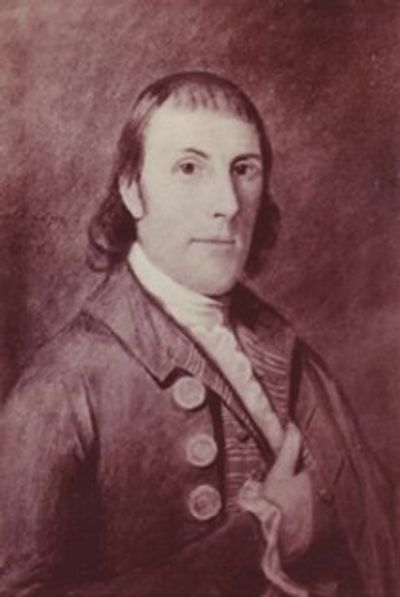Benjamin Hanks
The History
Col. Benjamin Hanks was born to Uriah and Irene (Case) Hanks in Mansfield, CT. in 1755. Not a lot is known of Hanks’s early life although it is well documented his time as a drummer in Putnam’s Third Connecticut Regiment during the American Revolution. He also participated with another great American Patriot, Paul Revere on his famous midnight ride at the young age of 20.
In about 1777, Hanks marries Alice Hovey, leaves Boston and moves to Windham, CT. It was about this time that he first advertises as a metal-smith but also as a clock maker. It is also documented that he was a talented gold and silver smith probably making some jewelry as well as other small decorative items. Hanks only stays in Windham for a few years, as in 1780 it’s known that he moves to Litchfield, CT.

Benjamin Hanks at just the age of 25, begins to build a house and a work shop on some property he purchases in Litchfield in 1780. His first “major” project that he got was an order to build a clock for the Old Dutch Church in New York City. Hanks was a particularly talented mechanic and had apprenticed under Thomas Harland in Norwich, CT. as a late teenager. One of the interesting things about Hanks during this time period was that he had invented a clock that would wind itself by air. In 1783 he succeeded in receiving a patent for this clock. The patent stated that the clock would “wind itself up by use of air” and that it would “continue to function until the mechanical parts were worn out due to friction”.
It’s not really known for sure when Col. Hanks starts to advertise for casting bells, or really when he cast his first bell, but we know for sure that he made one of his early bells in August of 1787 for the Litchfield Meeting House. Being the traveler that he was, he again didn’t stay in one place too long and by 1790 he had made his way to Mansfield, CT. and again set up a business as a clock maker and bell founder. The local name of this new business was Hanks Hill Foundry. Again, things get a little fuzzy about what he spent the next 15 or 20 years doing but we know he was casting bells and building clocks as there are many that still survive.
In 1808 when Col. Hanks set his son Julius up in the brass foundry business in Gibbonsville, NY. right across the Hudson River from Troy. The foundry was named Benjamin Hanks & Son. In July of that year, Gibbonsville's new foundry advertised the manufacture of church bells, tower clocks, and surveying instruments. This was the very first advertisement for bells in Troy, which would last for nearly 150 years.
In 1819 a young man by the name of Andrew Meneely was apprenticed to Julius. Andrew, who had been born in Gibbonsville on March 19, 1802, was the second child of Andrew and Eleanor (Cobb) Meneely, immigrants who had come to New York from Northern Ireland in 1795.
When Andrew's apprenticeship was over, he went to work for Julius' brother Horatio, who had also apprenticed at the Gibbonsville foundry. Horatio had set himself up as an instrument and small bell maker in Auburn, New York, in 1818, to take advantage of business opportunities attendant on the construction of the Erie Canal. During Andrew's years in Auburn, he met Horatio's cousin Philena Hanks when she and another cousin from Mansfield visited Horatio there. Philena was the daughter of Olive (Freeman) and Rodney Hanks, Col. Benjamin's younger brother.
In 1825, Julius abandoned his old shop and foundry in Gibbonsville for a new location in Troy, on the northeast corner of Fulton and Fifth. Andrew, sensing the opportunity, married Philena and acquired the Gibbonsville property.

At the same time (1826) Horatio closed his shop in Auburn and moved back to Troy, where he ran a small shop supporting the local mathematical instrument trade until 1828. In Troy, Julius also continued to manufacture "church bells, town clocks, copper and brass castings, and surveyors' instruments of the most improved construction." But across the river in Gibbonsville, Julius' former apprentice Andrew began to compete for the same market.
Benjamin Hanks died in 1824 but not before creating one of the most important American bell foundry legacies. From Benjamin came the bell foundries of many of his son’s, nephews and even the bell foundry of the great Andrew Meneely.
There are not a lot of bells that still exist that were cast by Benjamin, Julius or Horatio. The ones that still exist are treasures that should be well taken care of.

ceCopyright © 2025 T Verdin Legacy Bellworks - All Rights Reserved.
This website uses cookies.
We use cookies to analyze website traffic and optimize your website experience. By accepting our use of cookies, your data will be aggregated with all other user data.